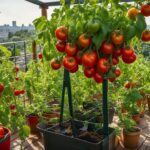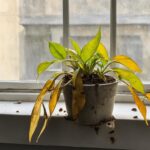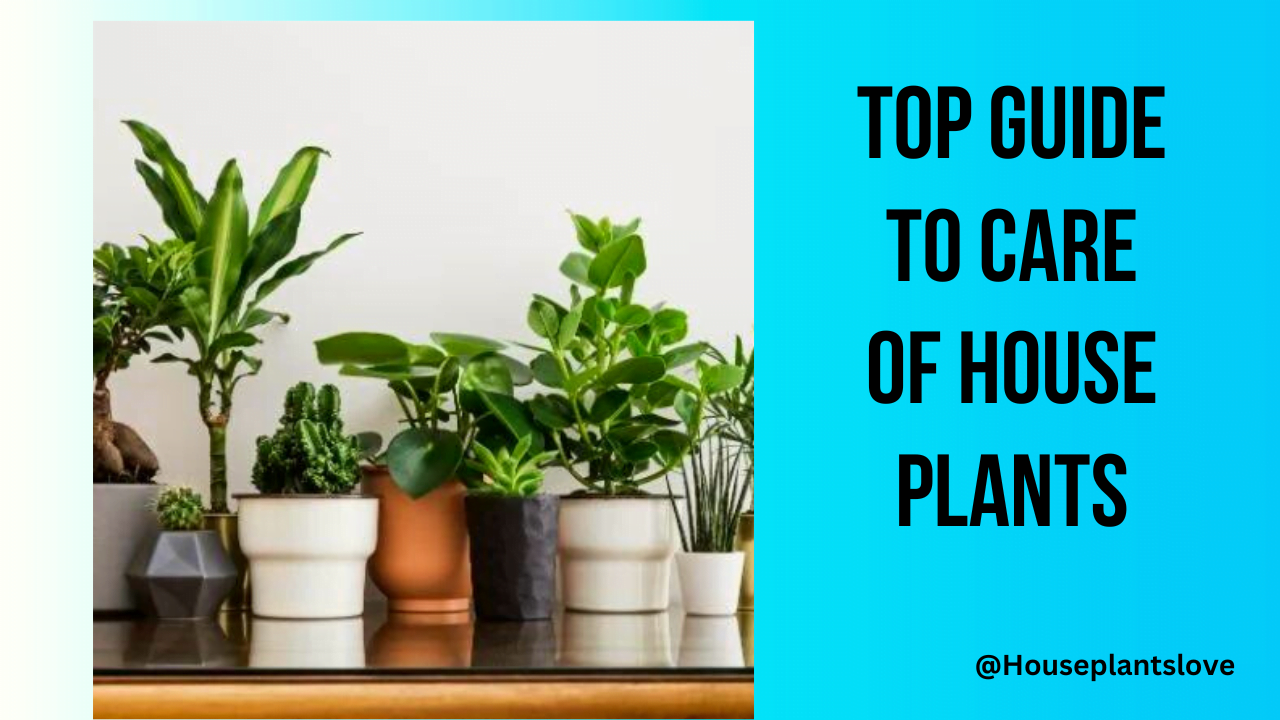Hibiscus Grow and Care Guide in winter and summer, Types, Pruning, Light, Water, Soil, Temperature, Fertilizer, Propagating, Growing in Pots & Common Pest Treatment
Growing hibiscus can be a rewarding experience, whether you want to add a splash of color to your garden or brighten up your indoor space. These vibrant flowers, known for their trumpet-like shape and large size, come in a variety of species, including trees, shrubs, and annuals or perennials. In this guide, I will provide you with valuable tips on how to successfully grow and care for hibiscus plants, covering everything from temperature requirements to pruning techniques.
Key Takeaways:
- Choose the right hibiscus species based on your climate and growing conditions.
- Consider growing hibiscus in containers for flexibility and space optimization.
- Provide the optimal temperature range for your hibiscus plants to thrive.
- Ensure proper watering and fertilizing practices for healthy growth and blooming.
- Regularly prune your hibiscus plants to maintain shape, size, and overall health.
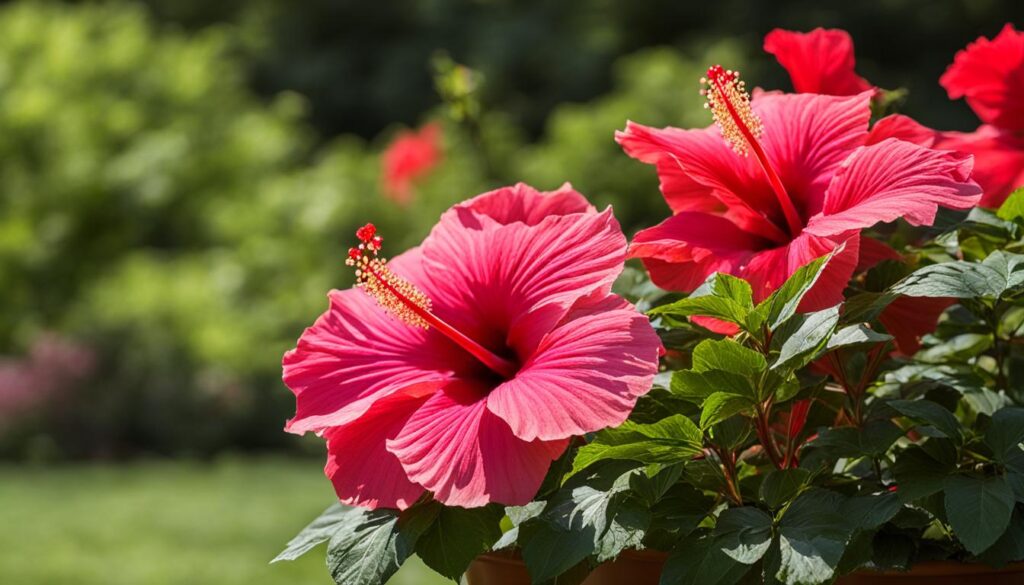
Choosing the Right Hibiscus Species
Hibiscus plants offer a beautiful array of vibrant flowers, but not all species are created equal in terms of hardiness and growing requirements. When selecting hibiscus for your garden or indoor space, it’s essential to choose the right species that suits your specific needs.
The most commonly used hibiscus species in landscaping is Hibiscus rosa-sinensis. This versatile species can thrive both indoors as a houseplant and outdoors in tropical conditions. Its large, trumpet-shaped flowers in various colors make it a popular choice among gardening enthusiasts.
However, for those residing in colder climates, it’s important to consider hardy hibiscus species that can withstand lower temperatures. One such species is Hibiscus syriacus, commonly known as the Rose of Sharon. These hardy hibiscus plants can tolerate frost and are suitable for USDA zones 5 to 9.
Whether you opt for the tropical beauty of Hibiscus rosa-sinensis or the cold hardiness of Hibiscus syriacus, both species offer stunning blooms that will enhance any garden or indoor space.
Key Points:
- Hibiscus rosa-sinensis is a versatile species suitable for indoor and outdoor cultivation.
- Hibiscus syriacus, also known as Rose of Sharon, is a hardy hibiscus species that can tolerate lower temperatures.
- Consider your climate and specific growing conditions when choosing the right hibiscus species for your garden or indoor space.
Growing Hibiscus in Containers
Growing hibiscus in containers is a great option for gardeners with limited outdoor space or those who want the flexibility to move their plants around. Container gardening allows you to enjoy the beauty of hibiscus while making the most of your available space.
When choosing shape and size of containers for your hibiscus, opt for large pots with good drainage. Hibiscus plants have an extensive root system, so providing ample space for growth is essential. Additionally, ensure that the containers have drainage holes to prevent waterlogging and root rot.
Container Gardening Tips:
- Select a large container with good drainage.
- Choose a potting mix that is well-draining and suitable for hibiscus.
- Place a layer of gravel or broken pottery at the bottom of the container to improve drainage.
- Position your container in an area that receives at least 6 hours of sunlight per day.
- Water the hibiscus regularly, keeping the soil moist but not waterlogged.
- Apply a balanced slow-release fertilizer according to the instructions on the packaging.
- Provide some afternoon shade for your hibiscus in hot weather to prevent stress and sunburn.
By following these container gardening tips, you can successfully grow hibiscus in pots and enjoy the vibrant blooms they provide.
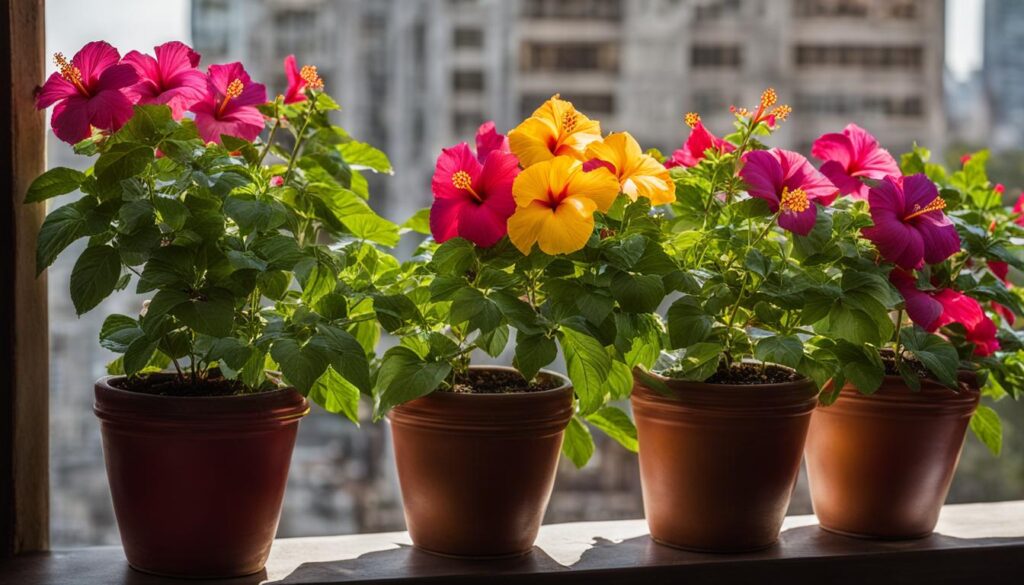
Temperature Requirements for Hibiscus
Hibiscus plants have specific temperature requirements for optimal growth. Understanding these requirements is essential for maintaining the health and blooming of your hibiscus plants.
Tropical hibiscus varieties prefer daytime temperatures between 65 to 75°F (18-24°C) and a minimum temperature of 55°F (13°C). These plants thrive in warm climates and are suitable for outdoor cultivation in regions with tropical or subtropical climates.
On the other hand, hardy hibiscus species like the Rose of Sharon can tolerate colder temperatures and are more adaptable to varying climates. They can be grown in USDA zones 5 to 9, making them suitable for a wider range of geographical locations.
To help you visualize the temperature requirements for hibiscus, the table below highlights the best temperature ranges for both tropical and hardy hibiscus varieties:
| Hibiscus Variety | Daytime Temperature Range | Minimum Temperature |
|---|---|---|
| Tropical Hibiscus | 65-75°F (18-24°C) | 55°F (13°C) |
| Hardy Hibiscus | Varies depending on the USDA zone | Varies depending on USDA zone |
By ensuring your hibiscus plants are exposed to the appropriate temperature ranges, you can create an environment that promotes their overall health, growth, and vibrant blooming.
Watering and Fertilizing Hibiscus
Proper watering and fertilizing are essential for the health and blooming of hibiscus plants. To ensure optimal growth and vibrant flowers, it’s important to meet their specific water requirements and provide the necessary nutrients through fertilization.
Watering Hibiscus Plants
When it comes to watering hibiscus, finding the right balance is key. These plants prefer moist but well-drained soil, so overwatering should be avoided. During the blooming stage, hibiscus may require more frequent watering, especially in warmer weather.
However, during colder periods, such as winter or cooler fall temperatures, hibiscus plants should be watered less often. Allow the soil to dry slightly between waterings to prevent waterlogged roots.
Fertilizing Hibiscus Plants
Fertilizers play a crucial role in supplying the necessary nutrients for healthy hibiscus growth and blooming. During the summer growing season, hibiscus plants benefit from regular fertilization with a high-potassium fertilizer. Potassium promotes flower production and overall plant vigor.
It’s important to refrain from fertilizing hibiscus plants during the winter months when they experience dormancy. Applying fertilizer during this time can disrupt the natural growth cycle and potentially harm the plants.
Remember to follow the manufacturer’s instructions when applying fertilizer to ensure the proper dosage and application frequency for your hibiscus plants.
Pruning Hibiscus for Healthy Growth
Pruning hibiscus plants is an essential step in maintaining their shape, size, and overall health. Regular pruning not only helps to prevent the plants from becoming overgrown but also encourages new growth and more abundant flowering. By following the correct hibiscus pruning techniques, you can ensure that your plants stay vibrant and beautiful.
Best Time to Prune Hibiscus
The ideal time to prune hibiscus is after flowering. This is usually in late winter or early spring, depending on the specific hibiscus species and your location. Pruning immediately after flowering allows the plants to recover and produce new growth before the next blooming season.
You can also read about Beautiful Flower Plants for Autumn
How to Prune Hibiscus
To prune the hibiscus, start by cutting back each branch to a leaf node at the desired height. A leaf node is the point where a leaf attaches to the stem. Make a clean cut just above the leaf node, ensuring that you do not leave any stubs. By pruning to a leaf node, you encourage the growth of new side shoots and promote a bushier, more compact plant.
Improving Air Circulation
As you prune hibiscus, it’s important to remove any old wood from the center of the plant. This helps improve air circulation, reducing the risk of fungal diseases. Removing old wood also allows more sunlight to reach the inner branches and stimulates new growth.
After pruning, be sure to clean up any fallen leaves or debris from around the base of the plant. This helps prevent the spread of diseases and pests.
Annual Pruning
Pruning hibiscus should be done on an annual basis, especially for hardy types that tend to become unruly if left unpruned. By maintaining regular pruning habits, you can keep your hibiscus plants healthy and in shape throughout the year.
Common Problems and Diseases of Hibiscus
Hibiscus plants can be susceptible to various problems and diseases. Hibiscus enthusiasts need to be aware of these issues and take proper measures to prevent and treat them. In this section, I will discuss some of the common problems and diseases that can affect hibiscus plants.
Hibiscus Insect Pests
Hibiscus plants are often targeted by a range of insect pests that can cause damage to the leaves, flowers, and overall health of the plant. Some of the common insect pests of hibiscus include:
- Aphids
- Japanese beetles
- Thrips
- Mealybugs
- Whiteflies
- Scale
These pests can feed on the sap of hibiscus plants, leading to stunted growth, yellowing leaves, distorted flowers, and even plant decline. Regular inspection and prompt action are crucial for controlling and managing these pests.
Hibiscus Diseases
Hibiscus plants can also be susceptible to various diseases that can negatively impact their health and appearance. Some common diseases that can affect hibiscus include:
- Armillaria root rot
- Botrytis blight
- Various leaf spots
These diseases can cause wilting, yellowing leaves, black or brown spots on leaves, and overall decline in the plant’s vitality. Preventive measures such as adequate air circulation, proper watering, and avoiding overhead watering can help minimize the risk of these diseases.
Here is an informative table summarizing the common problems and diseases of hibiscus plants:
| Problem/Disease | Symptoms | Treatment |
|---|---|---|
| Aphids | Stunted growth, distorted leaves and flowers, honeydew residue | Remove pests with a strong jet of water or use insecticidal soap |
| Japanese beetles | Skeletonized leaves, small holes in flowers | Handpick beetles or use insecticides specifically labeled for Japanese beetles |
| Thrips | Distorted flowers, silvery streaks on leaves | Prune affected plant parts and apply insecticidal soap or neem oil |
| Mealybugs | White, cottony clusters on leaves, stems, and flowers | Remove mealybugs with a cotton swab dipped in alcohol or use insecticidal soap |
| Whiteflies | Tiny white flies fluttering around the plant, sticky residue on leaves | Introduce beneficial insects or use yellow sticky traps |
| Scale | Small, oval-shaped insects on leaves and stems, sticky residue | Remove scale insects with a cotton swab dipped in alcohol or use insecticidal soap |
| Armillaria root rot | Yellowing leaves, stunted growth, decayed roots | Improve drainage, remove infected plant parts, apply fungicides if necessary |
| Botrytis blight | Brown spots on flowers, gray mold on leaves and buds | Remove infected plant parts, improve air circulation, avoid overhead watering |
| Leaf spots | Black or brown spots on leaves, yellowing, defoliation | Remove infected leaves, apply fungicides if necessary |

It is important to note that early detection, proper cultural practices, and targeted treatments are key to managing and preventing hibiscus problems and diseases. Regular observation, maintaining good garden hygiene, and providing optimal growing conditions can go a long way in ensuring the health and beauty of your hibiscus plants.
You can also read How To Save Tulsi Plant From Dying
Hibiscus and Pet Safety
When it comes to keeping our beloved pets safe, it’s important to be aware of any potential dangers lurking in our surroundings. While most hibiscus plants are not toxic to pets like dogs and cats, certain species can cause gastrointestinal distress if ingested. One such species is the Rose of Sharon (Hibiscus syriacus).
As pet owners, it’s crucial to exercise caution if you have hibiscus plants in your home or garden and are unsure of their species. Monitor your pets closely to prevent any unwanted snacking on hibiscus leaves or flowers, especially if they tend to be curious about plants.
If you suspect that your pet has ingested hibiscus and is experiencing symptoms such as nausea, vomiting, or diarrhea, it’s important to seek veterinary care immediately. A professional can assess the situation and provide appropriate treatment if necessary.
Remember to create a safe environment for your pets by carefully selecting the plants in your surroundings. While hibiscus can be a beautiful addition to your garden or home, it’s always best to prioritize the well-being of your furry friends.
Summary:
- Most hibiscus plants are not toxic to dogs and cats.
- Rose of Sharon (Hibiscus syriacus) can cause gastrointestinal distress if ingested.
- Monitor your pets closely and seek veterinary care if any signs of hibiscus poisoning occur.
- Create a safe environment by selecting pet-friendly plants.
Where to Buy Hibiscus Plants
If you’re looking to add the vibrant beauty of hibiscus plants to your garden, there are several options for purchasing them. Garden centers and nurseries are popular choices where you can find a variety of hibiscus plants to choose from. These local establishments often provide expert advice and guidance to help you select the right plant for your specific needs.
When purchasing hibiscus plants, whether from a garden center or online retailer, it’s important to ensure they are healthy and free from pests or diseases. Check for vibrant foliage, and sturdy stems, and ensure there are no signs of wilting or discoloration. By carefully selecting healthy plants, you can set yourself up for successful growth and a stunning display of hibiscus flowers.
FAQ
How do I grow and care for hibiscus plants?
To grow and care for hibiscus plants, you need to provide the right temperatures, water them properly, fertilize them regularly, and prune them as needed. It’s also important to monitor for any potential problems or diseases and take appropriate measures to prevent or treat them.
What are the best temperatures for hibiscus plants?
Tropical hibiscus plants prefer daytime temperatures between 65 to 75°F (18-24°C) and a minimum temperature of 55°F (13°C). Hardy hibiscus species can tolerate colder temperatures and can be grown in USDA zones 5 to 9.
Can I grow hibiscus in containers?
Yes, hibiscus plants can be grown in containers, which is especially useful if you have limited outdoor space or want the flexibility to move them around. When growing hibiscus in containers, choose a large container with good drainage and ensure the plants are slightly root-bound for optimal growth. Providing some afternoon shade in hot weather can also benefit hibiscus in containers.
How often should I water and fertilize hibiscus plants?
Hibiscus plants prefer moist but well-drained soil. During the blooming stage, they require more water, while in colder weather, they need less frequent watering. Fertilize hibiscus with a high-potassium fertilizer during the summer and refrain from fertilizing in winter to provide the necessary nutrients for healthy growth.
When and how should I prune hibiscus plants?
The best time to prune hibiscus is after flowering. Cut back each branch to a leaf node at the desired height. Removing old wood from the center of the plant can improve air circulation. Pruning should be done annually, especially for hardy hibiscus types that tend to become unruly if left unpruned.
What are the common problems and diseases of hibiscus plants?
Hibiscus plants can be susceptible to insect pests such as aphids, Japanese beetles, thrips, mealybugs, whiteflies, and scale. Diseases that can affect hibiscus include Armillaria root rot, Botrytis blight, and various leaf spots. It’s important to monitor the health of hibiscus plants and take appropriate measures, such as proper watering and providing adequate air circulation, to prevent and treat these problems.
Are hibiscus plants toxic to pets?
Most hibiscus plants are not toxic to pets like dogs and cats. However, some species, such as Rose of Sharon (Hibiscus syriacus), can cause gastrointestinal distress if ingested. It’s important to be cautious if you have pets and are unsure of the specific species of hibiscus you have. Monitor your pets closely and seek veterinary care if any signs of poisoning, such as nausea, vomiting, or diarrhea, occur.
Where can I buy hibiscus plants?
Hibiscus plants can be purchased from various sources, including garden centers and online retailers. When buying hibiscus plants, ensure they are healthy, free from pests, and have no signs of disease.

